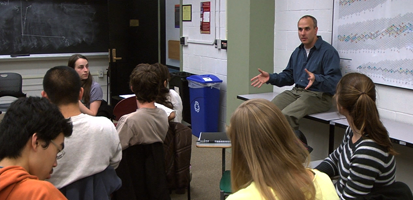Course Overview
This page focuses on the course 11.124 Introduction to Education: Looking Forward and Looking Back on Education as it was taught in Fall 2011 by Professor Erik Klopfer. Most content on this page also applies to the course 11.125 Introduction to Education: Understanding and Evaluating Education.
This course is an introductory course on teaching and learning science and mathematics in a variety of K-12 settings. Topics include education and media, education reform, the history of education, simulations, games, and the digital divide. This course is required for the Scheller Teacher Education Program (STEP) at MIT, through which students can earn a teaching license.
Course Outcomes
Course Goals for Students
- Sustained interest in education, grounded in knowledge of educational theories, history, and current events
- Understanding of a wide range of teaching and learning styles
- Appreciation for the constructivist approach, particularly hands-on, project-based, collaborative work
- Ability to pursue further courses, work, or other experiences related to education
Possibilities for Further Study and Careers
Courses at MIT:
- 11.125 Introduction to Education: Understanding and Evaluating Education
- 11.127J Computer Games and Simulations for Investigation and Education
- Educational Theory and Practice sequence (11.129, 11.130, 11.131)
› Expand/Collapse
Professional possibilities:
- Initial teaching certification in Massachusetts through the STEP program, completed by 8-12 students per year
- Careers in education, teaching, or educational technology
- Volunteer work or other involvement in education

Prof. Klopfer shares his thoughts at the end of a student-led discussion. (Image courtesy of MIT OpenCourseWare.)
In the following pages, Professor Eric Klopfer discusses specific aspects of his experience as the lead course instructor.
- Applying a constructivist approach
- Building discussion through online and in-class activities
- Guiding students to see the big picture
- Engaging students in their writing
- Teaching students with strong science and math backgrounds
Curriculum Information
Prerequisites
None
Requirements Satisfied
- HASS-S

- CI-H

- HASS Concentration: Education
- STEP Sequence
Offered
- Every fall

Breakdown by Degree Program
All undergraduate students, mostly sophomores and juniors.
Breakdown by Major
Varies
Typical Student Background
- Strong background in science and math, as is typical of MIT students
- Interested in education
Enrollment Cap
Student interest in the Scheller Teacher Education Program (STEP), including 11.124, has grown significantly in the past decade alongside increasing interest in education and social issues among the overall MIT student population. For 11.124 in particular, enrollment has surged, with 60-70 students trying to enroll in the Fall 2012 offering. A decade earlier, the course instructors had to advertise extensively to gather a class of 20 students. The class is capped at 25 students due to CI-H limitations. Students are selected based on interest in education, interest in the full STEP program, and seniority.
Ideal Class Size
About 25 students. In past classes with 12-14 students, there wasn’t enough diversity of opinion; in past classes with 32-35 students, it was difficult for everyone to be an active part of class discussions.
During an average week, students were expected to spend 12 hours on the course, roughly divided as follows:
In Class
- Two class sessions per week; 1.5 hours per session; 26 class sessions total.
Distribution of class time:
- 1/3: Student-led discussions and activities (Current Events and Chapter Readings)
- 1/6: Instructor-initiated discussions
- 1/4: Student Teaching (Modes of Teaching activity)
- 1/4: Other in-class activities
Out of Class
- Three formal written assignments: Straw Towers, Pulleys, and Technology Centered Environments
- Math games assignment
- Three in-class presentations/discussions: Town Hall, Ed Tech Poster, and Modes of Teaching Mini-Lesson
- Portfolio and final paper
- 18-22 hours of classroom observation
- Chapter reading assignment, including weekly participation in online and in-class discussion, as well as leading the discussion one week
- Current events, including weekly participation in discussion, as well as leading the discussion one week
- Readings
Semester Breakdown
| WEEK | M | T | W | Th | F |
|---|---|---|---|---|---|
| 1 |  |  |  |  |  |
| 2 |  |  |  |  |  |
| 3 |  |  |  |  |  |
| 4 |  |  |  |  |  |
| 5 |  |  |  |  |  |
| 6 |  |  |  |  |  |
| 7 |  |  |  |  |  |
| 8 |  |  |  |  |  |
| 9 |  |  |  |  |  |
| 10 |  |  |  |  |  |
| 11 |  |  |  |  |  |
| 12 |  |  |  |  |  |
| 13 |  |  |  |  |  |
| 14 |  |  |  |  |  |
| 15 |  |  |  |  |  |
| 16 |  |  |  |  |  |
 No classes throughout MIT
No classes throughout MIT Class session
Class session No class session scheduled
No class session scheduled Assignment due
Assignment dueInstructors (Prof. Eric Klopfer and Wendy Huang)
To inspire and encourage student learning and comprehension of the content covered in class. To design the syllabus and course content, create the assignments, lead in-class activities, and facilitate discussion.
- Prof. Eric Klopfer: To handle the majority of day-to-day class activities.
- Wendy Huang: To specifically handle the math-based units and student teaching portions of the course.
Teaching Assistant (Jason Haas)
To help prepare some materials, facilitate discussion, and work with the main instructors to grade and provide feedback on student papers.
Writing Tutor (Jo-Ann Graziano)
To lead a few in-class writing activities. To work with students outside of class to develop their drafts into polished final papers.


 Room 1 of 1
Room 1 of 1 